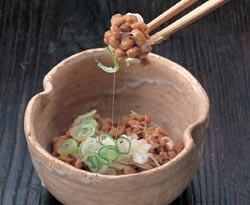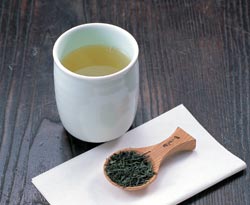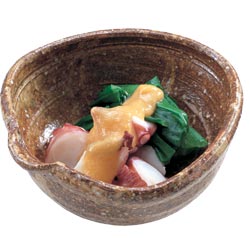|
Special Feature*
A treasure house of food for long life and youthful vigor
The staple food, rice, contains lecithin, which is known to improve brain function; oligosaccharide, which reinvigorates the intestines; and gamma amino butyric acid, which is said to help stabilize blood pressure.
Japanese cuisine would not be what it is without soybeans and soy products: these include miso bean paste, tofu, abura-age (deep-fried tofu), nimame (simmered soybeans), and natto (fermented soybeans). Soybeans are 35% protein, about the same as meat, and this has given them the moniker, "meat from the vegetable garden." They also contain a type of polyphenol and isoflavone. These have recently received favorable attention in Japan because they serve the purpose of a female hormone, not only preventing bone loss but even increasing bone mass. This is good news for middle-aged women worried about osteoporosis. Soybeans are also said to slow down the aging of human cells. And the sticky, stringy substance in natto is useful in preventing clot formation in blood vessels.
Miso soup is made from miso, which is a fermented soybean paste rich in amino acids. So it is basically an amino acid soup! It has promoted long life among the Japanese for centuries. Ingredients added to the soup include vegetables, tofu and seaweed, all excellent sources of vitamins, minerals, antioxidants and dietary fiber.
Fish contains DHA (docosahexaenoic acid), which is important in improving memory and learning power. It also contains EPA (eicosapentaenoic acid), well known as an agent that promotes blood circulation.
Japanese cuisine contains many other healthy, nutritious ingredients. Just three of these are black sesame seeds, which stimulate brain activity; umeboshi, which purify the blood; and green tea, which helps prevent cell aging. Traditional Japanese recipes are a veritable goldmine packed with secrets to long life and youthful living. 
Natto
 |
Soybeans are boiled and then fermented with the natto culture that spreads throughout the beans.
The resulting sticky, stringy substance contains a live enzyme called nattokinase, which prevents clots from forming in blood vessels.
The bean protein changes to amino acids during the fermentation process, making the protein easy to digest.
|
Green tea
 |
The Japanese, especially the older generations, drink green tea many times a day. Catechin, an astringent ingredient in green tea, helps prevent cell oxidization, cancer and lifestyle diseases. Research has shown that the cancer death rate in Shizuoka Prefecture, where green tea is harvested in huge quantities, is 20% lower than in the country as a whole.
|
Octopus and green onion in a vinegared miso dressing
 |
One common lesser side dish is chopped fish or shellfish with vegetables, all dressed with a sauce containing vinegar. Vinegar can help people think more clearly, because it rids the body and brain of lactic acid and other substances that build up and cause fatigue. The photo shows boiled octopus and green onions in a dressing of vinegar and miso. The Japanese like eating octopus. It is rich in protein and low in fat, and contains plenty of amino acids and taurine, both of which help prevent arterial sclerosis and protect eyesight from the aging process.
|
|